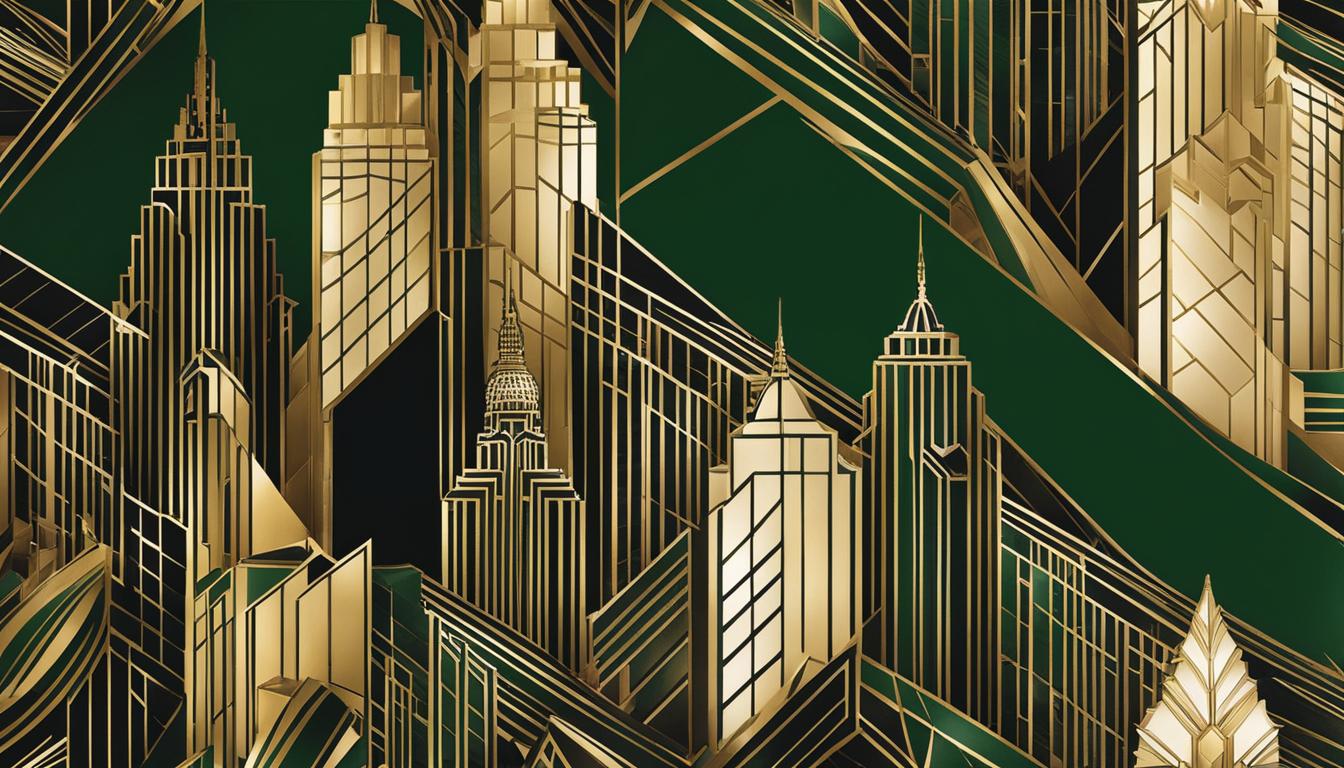Welcome to our exploration of Art Deco Art, a style that was prominent in the 1920s and 1930s. Art Deco is widely regarded as one of the most significant movements in design history, characterized by its sleek and sophisticated aesthetic. The Art Deco style incorporates a range of design elements, including geometric shapes, bold colors, and lavish ornamentation, all of which contribute to its enduring appeal.
Art Deco Art emerged during a time of great cultural change and social upheaval. The Roaring Twenties saw the rise of industrialization and technological progress, leading to a new sense of optimism and excitement. The Art Deco movement embodied this spirit of innovation, creativity, and glamour.
Key Takeaways:
- Art Deco Art is a prominent design style that emerged in the 1920s and 1930s.
- The Art Deco movement was characterized by its sleek and sophisticated aesthetic.
- Art Deco design elements include geometric shapes, bold colors, and lavish ornamentation.
- The Art Deco era was marked by cultural change and social upheaval.
- Art Deco embodied a spirit of innovation, creativity, and glamour.
The Origin and History of Art Deco
When we think of Art Deco, we often picture the glamour of the 1920s and 1930s. However, the movement actually began in the early 1900s, emerging as a response to the ornate and decorative styles that preceded it.
Art Deco was heavily influenced by the rise of industrialization and the machine age. Its streamlined geometric forms and bold colors were a celebration of modern technology and progress. Additionally, the style was shaped by global events such as World War I and the roaring twenties, which brought about a sense of liberation and avant-garde thinking.
Despite its modernist roots, Art Deco also incorporated elements of ancient cultures and traditional craftsmanship. Many Art Deco designs featured intricate patterns and luxurious materials, such as exotic woods, metals, and jewels.
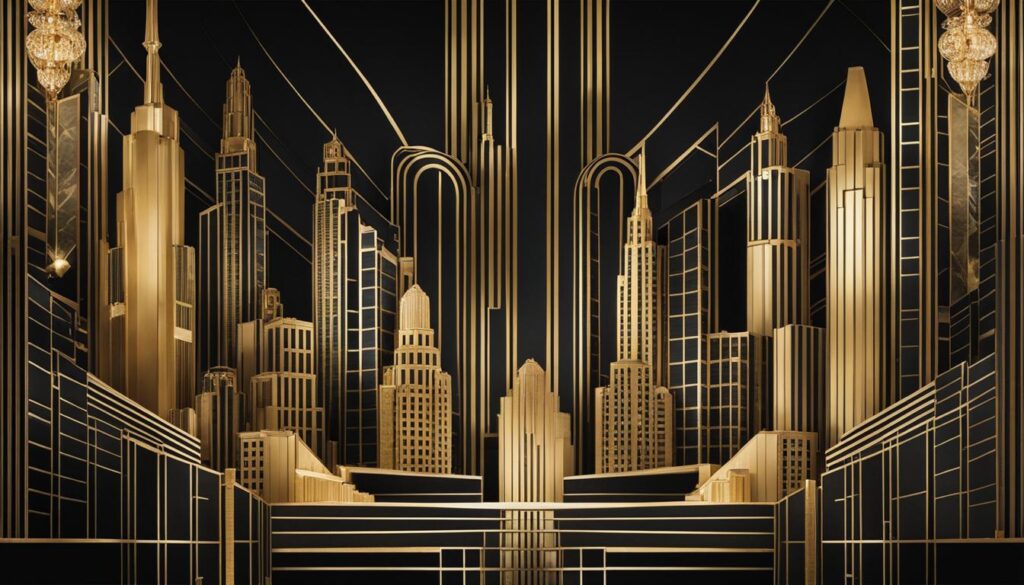
One of the most iconic Art Deco structures is the Chrysler Building in New York City. Completed in 1930, this skyscraper epitomizes the movement’s love for bold geometric shapes and lavish ornamentation. Art Deco also had a significant impact on the world of fashion, with designers such as Coco Chanel and Elsa Schiaparelli incorporating its sleek lines and bold colors into their creations.
As the decades passed, Art Deco fell out of favor and was replaced by other design movements. However, its influence can still be seen in contemporary design, as designers continue to draw inspiration from its bold, modernist aesthetic.
The Evolution of Art Deco
Art Deco evolved over time, reflecting the changing social and political climate of its era. In the 1920s, the style was characterized by its streamlined forms and bold geometric patterns. However, as the Great Depression took hold in the 1930s, Art Deco became more restrained and focused on simpler, more functional designs.
As World War II began, Art Deco fell out of favor as the world turned its attention towards military efforts. However, the style experienced a resurgence in the 1960s and 1970s, as people looked back to the glamour and luxury of the past.
Today, Art Deco remains an enduring and beloved style, with many enthusiasts and collectors seeking out its iconic pieces and unique designs.
Exploring Art Deco Architecture
Art Deco architecture is known for its striking appearance and unique features. From the 1920s to the 1940s, this style dominated cities around the world, creating an artistic movement that still influences modern architecture today.
Distinct Characteristics
The Art Deco architectural style is characterized by bold, geometric shapes, and lavish ornamentation. Buildings feature clean lines, bold colors, and streamlined forms, representing the era’s technological advancements and social changes.
One of the hallmark features of Art Deco architecture is the use of metal and concrete. These materials allowed architects to create innovative structures, such as skyscrapers and bridges, that were previously unthinkable.
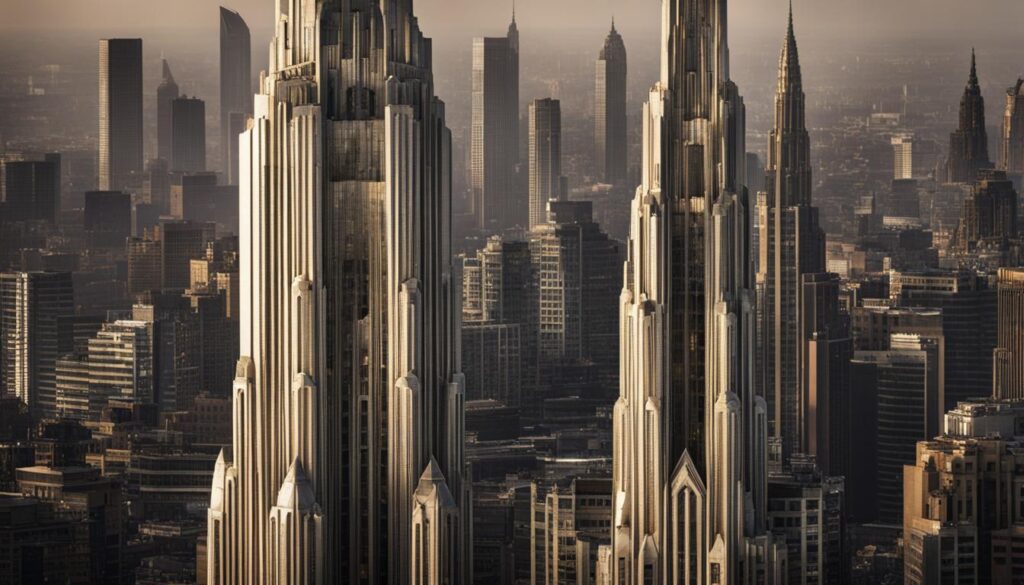
Iconic Examples
Some of the most iconic examples of Art Deco architecture include the Chrysler Building in New York City, the Hoover Dam in Nevada, and the Empire State Building in New York City. These buildings showcase the style’s grandeur and innovation, featuring intricate details and impressive heights.
But Art Deco architecture wasn’t just limited to grand buildings. It could also be found in everyday structures, such as apartment buildings, movie theaters, and gas stations. Even today, many Art Deco buildings continue to stand out in their urban environments, serving as historic landmarks and beloved symbols of their cities.
Legacy and Influence
Art Deco architecture continues to have a lasting influence on contemporary design. Its bold shapes and colors, use of industrial materials, and emphasis on innovation are still evident in modern buildings around the world. From Miami’s South Beach to the skyscrapers of Shanghai, the legacy of Art Deco architecture lives on, inspiring architects and designers to push the boundaries of what’s possible.
Art Deco Furniture: Style and Elegance
When it comes to Art Deco furniture, the emphasis is on sleek lines, luxurious materials, and exquisite craftsmanship. During the 1920s and 1930s, this style was all the rage, and many iconic pieces were created that have stood the test of time.
One of the most popular Art Deco furniture items is the cocktail cabinet, which epitomizes the era’s love of glamour and entertainment. These cabinets often featured intricate geometric patterns and were made from materials like mahogany, walnut, and rosewood.
Another hallmark of Art Deco furniture is the use of curved forms, such as in the popular curved sofa. These elegant pieces were often upholstered in plush velvets or silks and featured unique decorative elements like tassels and fringes.
Geometric side tables are also a staple of the Art Deco style, characterized by bold shapes and intricate inlays. These tables were often made from materials like chrome, glass, and exotic woods, and were designed to be functional yet aesthetically pleasing.
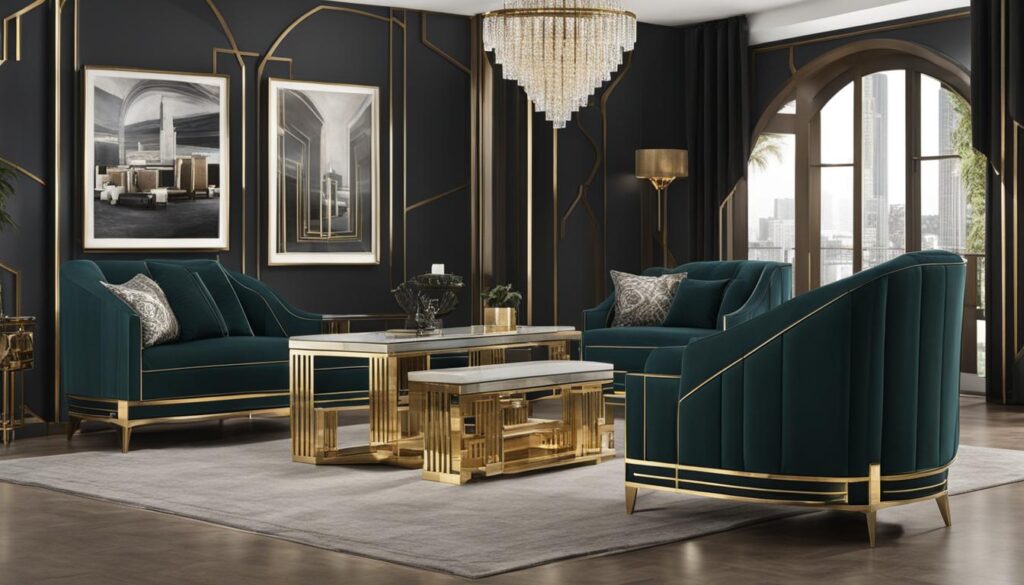
Overall, Art Deco furniture is renowned for its style and elegance, and its influence can still be seen in contemporary design today. Whether you’re looking to add a touch of glamour to your home or simply appreciate the craftsmanship of this iconic era, Art Deco furniture remains a beloved style that never goes out of fashion.
Art Deco Paintings: Captivating Modernism
When it comes to Art Deco paintings, the style is characterized by bold colors, geometric shapes, and streamlined subjects. These paintings are a reflection of the modernism that was taking over the world in the early 20th century. The movement was all about rejecting traditional styles and embracing new technology, which is evident in the sleek and streamlined designs of the era.
One of the most iconic Art Deco painters was Tamara de Lempicka, who was known for her glamorous portraits of the wealthy elite. Her paintings are characterized by sharp angles and bold colors, often featuring women in luxurious outfits and striking poses. Another notable Art Deco painter was Tamara’s contemporary, Erté. He was famous for his elegant fashion illustrations, which depicted women in luxurious clothing and accessories, often in art deco-inspired settings.
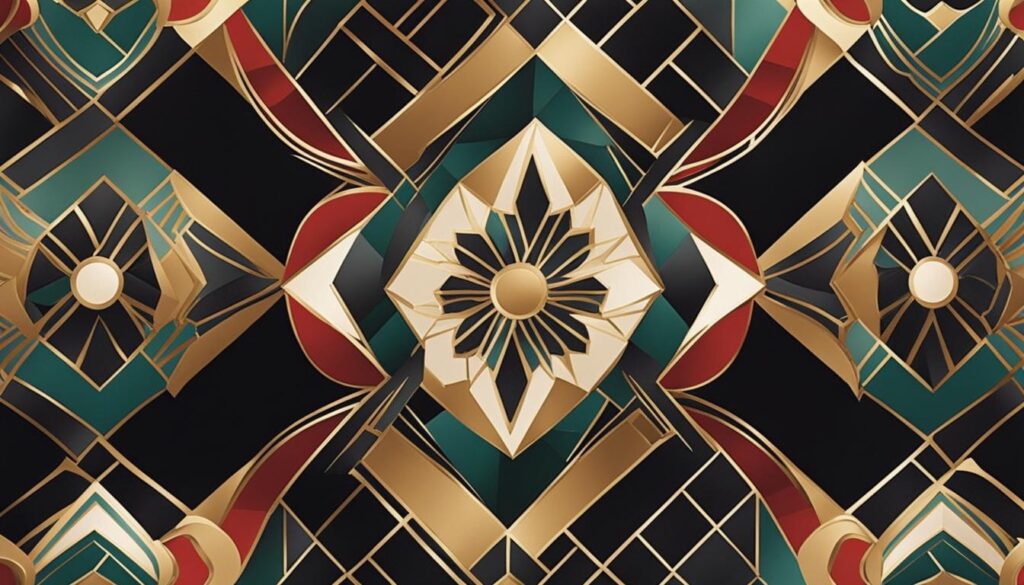
Other notable artists of the era include Jean Dunand, who was known for his intricate lacquer work, and Jean Dupas, who created stunning art deco murals for buildings such as the French ocean liner SS Normandie.
One of the most famous Art Deco paintings is “Iris” by artist Tamara de Lempicka, which features a woman with angular features and bold red lips. The painting captures the glamour and sophistication of the Art Deco era, with its vivid color palette and intricate design.
Art Deco paintings continue to inspire contemporary artists, designers, and fashion houses today. The bold colors and geometric shapes of the style have remained influential, and can be seen in everything from graphic design to interior decor.
Art Deco Artists: Icons of the Era
Art Deco art was created by some of the most visionary artists of the early 20th century. Their works brought a new level of sophistication and glamour to the art world, inspiring a generation of designers and creatives.
Tamara de Lempicka was one of the most iconic Art Deco artists, known for her elegant portraits of wealthy and prominent figures. Her use of bold colors and geometric shapes captured the essence of the Art Deco movement and remains influential to this day.
Erté, whose real name was Romain de Tirtoff, was a prolific artist and designer who created stunning fashion illustrations and set designs. His work epitomized the Art Deco style, with its emphasis on luxury, glamour, and ornate detail.
A.M. Cassandre was a renowned graphic designer and poster artist, whose bold and innovative designs transformed advertising in the 1920s and 30s. His use of bold typography, dynamic compositions, and abstract forms made him one of the most important Art Deco artists of his time.
Paul Colin was a celebrated French poster artist, whose dynamic and colorful designs helped define the Art Deco style. His posters for music shows and cabarets, which often featured bold and exaggerated figures, remain iconic examples of the Art Deco aesthetic.
Jean Dupas was another influential Art Deco painter and designer, whose elegant and stylized works graced everything from luxury ocean liners to the walls of high-end apartments. His use of geometric shapes, vivid colors, and clean lines helped define the visual language of the Art Deco era.
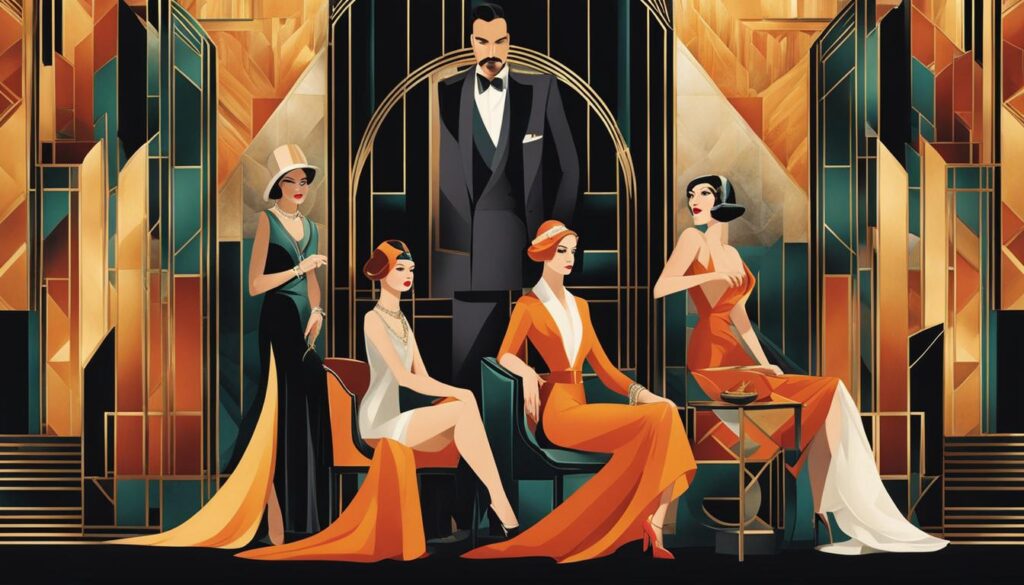
These are just a few examples of the many groundbreaking artists who created Art Deco art. Their legacy has endured over the decades, inspiring new generations of artists and designers to create bold, innovative, and glamorous works that capture the essence of the Art Deco style.
Conclusion
And there you have it – a comprehensive look at the fascinating world of Art Deco Art. As we’ve explored throughout this article, the Art Deco style, movement, and design are all intrinsically linked, and their influence can be seen in various artistic disciplines today.
From the origins of Art Deco in the Roaring Twenties to its enduring impact on contemporary design trends, it’s clear that this movement has left an indelible mark on the world of art and architecture. As we’ve seen, Art Deco architecture is characterized by distinct geometric shapes, lavish ornamentation, and streamlined forms. Meanwhile, Art Deco furniture is known for its sleek lines, luxurious materials, and exquisite craftsmanship.
Art Deco paintings, too, are captivating in their modernism, featuring bold colors, geometric shapes, and streamlined subjects. The visionary artists who pioneered this movement, such as Tamara de Lempicka and Erté, remain icons of the era due to their unique and innovative contributions to the Art Deco style.
Reflecting on Art Deco’s enduring appeal, it’s clear that this movement continues to captivate and inspire people across the globe, as evidenced by its continued influence on contemporary design trends.
Whether it’s the iconic buildings that define Art Deco architecture or the sleek and elegant furniture pieces that reflect its style, there’s no denying the lasting impact of this movement on the world of art and design.
So, as we conclude our deep dive into the world of Art Deco Art, we encourage you to continue exploring this fascinating style. Who knows – you might just discover a new appreciation for the beauty and elegance of Art Deco design.
FAQ
What is Art Deco Art?
Art Deco Art refers to a style that emerged in the 1920s and 1930s, characterized by its bold geometric shapes, luxurious materials, and sleek lines. It encompasses various art forms, including architecture, furniture, paintings, and fashion.
What is the significance of Art Deco Art?
Art Deco Art represents a significant period in design history, reflecting the cultural, social, and technological changes of the time. It symbolizes a shift towards modernism and the desire for elegance, luxury, and progress.
What are the key design elements of Art Deco Art?
Art Deco Art is known for its use of geometric shapes, symmetrical patterns, and bold colors. It often incorporates lavish ornamentation, streamlined forms, and the integration of industrial materials, such as chrome and glass.
Where did the Art Deco movement originate?
The Art Deco movement originated in Paris, France, in the 1920s. It quickly spread across Europe and the United States, becoming a prominent design style that influenced various artistic disciplines.
What are some famous examples of Art Deco architecture?
Famous examples of Art Deco architecture include the Empire State Building in New York City, the Chrysler Building in New York City, and the Radio City Music Hall in New York City. These buildings showcase the distinct characteristics of Art Deco design.
What types of furniture are associated with Art Deco style?
Art Deco furniture is known for its sleek lines, luxurious materials, and elegant designs. Common types include cocktail cabinets, curved sofas, geometric side tables, and streamlined chairs.
Who were some notable artists of the Art Deco movement?
Notable artists of the Art Deco movement include Tamara de Lempicka, known for her glamorous portraits, and Erté, renowned for his elegant fashion illustrations. These artists and many others contributed to the diverse range of artistic expressions within the Art Deco style.

